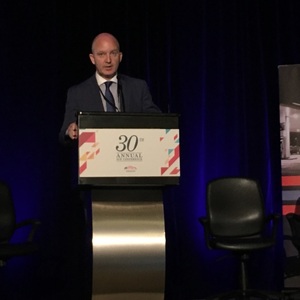ACE's annual conference opens with export discussion

BBI INTERNATIONAL
August 16, 2017
BY Lisa Gibson
The U.S. Grains Council Advisory Team for Ethanol hopes to increase the volume of exported ethanol to 2.3 billion gallons by 2026, which is double export projections for this year, according to Jim Galvin, CEO and director of Lakeview Energy and appointed leader of the USGC ethanol advisory team. Galvin addressed the crowd at the American Coalition for Ethanol Annual Conference Aug. 16 at the DoubleTree by Hilton Hotel in Omaha and told attendees the U.S. needs to be more aggressive in expanding export markets.
In 2016, exports exceeded 1 billion gallons, the second-highest volume on record, Galvin said. As of the end of June, the U.S. had exported 687 million gallons of ethanol, 53 percent more than it had at the same time last year. Canada and Brazil are the main importers of U.S. ethanol, but Brazil joins Peru and Columbia in a group of countries that have imposed or are trying to impose disruptive trade policies, Galvin said. Brazil’s tariffs, in particular, likely would affect U.S. ethanol imports, he told the crowd, but the timeline is unclear.
Advertisement
The U.S. ethanol industry needs to develop new, sustained export markets, Galvin said. “Leave no stone unturned in terms of developing those export markets.” But the industry needs the government as an ally, he cautioned, calling on the crowd to push for favorable policies.
U.S. ethanol is the cheapest octane in the world. “So we have to be competitive to get into the export markets.” Moving forward, the Asia-Pacific region will be a main focus area for U.S. ethanol exports, he said. The greenhouse gas (GHG) mitigation benefits of ethanol—40 percent—is a crucial focal point, he said, particularly in the Asian countries that are acknowledging their air pollution issues, such as China. “China is erratic, but we can’t ignore China.”
Advertisement
Galvin told attendees that the U.S. ethanol industry has some “tailwinds” to help it push forward in exports: Mexico is moving to an E10 blend; Japan will announce revised energy policy allowing U.S. ethanol; Canada is assessing a move to an E10 blend; China is reviewing its clean air policy; and car manufacturers are looking at E25 and E30 to boost engine performance and reduce emissions. “An awful lot of positives to look at in terms of momentum across the globe,” Galvin said.
“There’s massive potential to grow exports, but it needs to be in a measured way,” he said. “We cannot impose ourselves on these markets. We have to make sure we have a fuel that’s marketable on the global market.”
Related Stories
The USDA has announced it will delay opening the first quarterly grant application window for FY 2026 REAP funding. The agency cited both an application backlog and the need to disincentivize solar projects as reasons for the delay.
Neste and DHL Express have strengthened their collaboration with the supply of 7,400 tons (9.5 million liters) of neat, i.e. unblended, Neste MY Sustainable Aviation Fuel to DHL Express at Singapore Changi Airport starting July 2025.
CoBank’s latest quarterly research report, released July 10, highlights current uncertainty around the implementation of three biofuel policies, RFS RVOs, small refinery exemptions (SREs) and the 45Z clean fuels production tax credit.
The U.S. Energy Information Administration maintained its forecast for 2025 and 2026 biodiesel, renewable diesel and sustainable aviation fuel (SAF) production in its latest Short-Term Energy Outlook, released July 8.
XCF Global Inc. on July 10 shared its strategic plan to invest close to $1 billion in developing a network of SAF production facilities, expanding its U.S. footprint, and advancing its international growth strategy.
Upcoming Events










